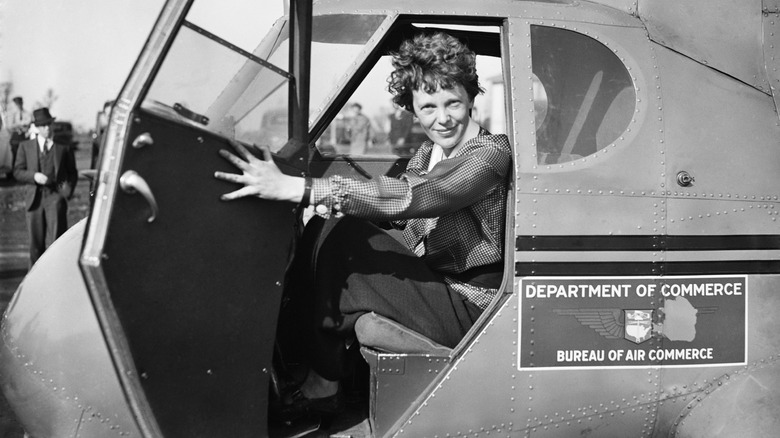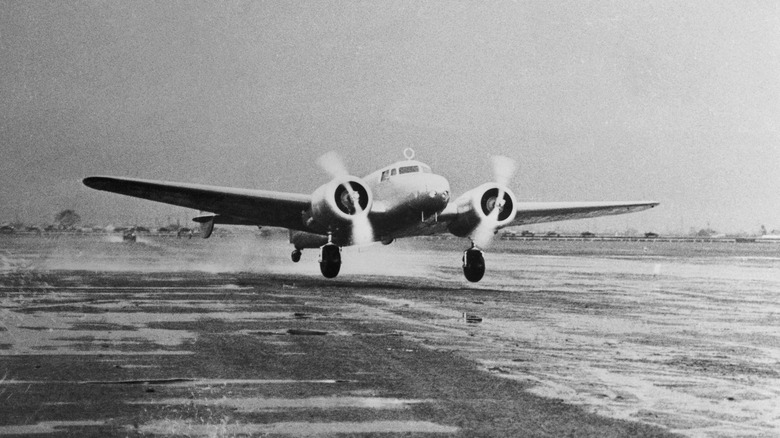Why The Mystery Of What Happened To Amelia Earhart's Plane May Finally Be Over
Aviator Amelia Earhart's 1937 disappearance kickstarted one of the most enduring mysteries in aviation history. As the National Air and Space Museum explains, Earhart and her navigator Fred Noonan set out east from Oakland, California on May 21 in a signature, twin-engine Lockheed Electra to travel all the way around the world. By June 29 they'd covered 22,000 miles and reached Lae, New Guinea. By July 2 they were in the air again and headed toward their next stop at Howland Island. Per the Earhart Project, they'd already made 29 stops by then. There would have been only one more stop after Howland Island — Honolulu, Hawaii — before the pair successfully landed back in Oakland. But they never arrived at Howland Island, and no one knows exactly what happened.
The most obvious, Occam's razor-like reason for Earhart's and Noonan's disappearance would be, "Their plane crashed," and that's that. And yet some of the more common conspiratorial theories include Earhart landing elsewhere and vanishing for some reason, Earhart being a spy, Earhart getting captured by Japanese forces, Earhart assuming another identity, and so forth. And now, after 85 years, it looks like we might have an actual lead — not a definitive answer, though — about what happened to her. As NBC News explains, Tony Romeo, a former Air Force intelligence officer and CEO of underwater survey company Deep Sea Vision, claims they've taken a sonar snapshot of Earhart's Lockheed Electra under the waves about 100 miles off Howland Island.
The right shape for Earhart's plane
When Amelia Earhart and Fred Noonan vanished in 1937, Navy and Coast Guard search-and-rescue missions combed 250,000 square miles in search of them. By the final week of the search this undertaking cost $250,000 per day, or $5.3 million per day adjusted for inflation by 2024, as Time reported. But cost didn't matter — it was Amelia Earhart, after all. She was an icon of American culture and an inspiration for young women across the globe. She was the first woman to fly solo across the Atlantic Ocean, won the Distinguished Flying Cross for "heroism or extraordinary achievement while participating in an aerial flight," founded the Ninety-Nines to advance the goals of women in aviation, set speed and altitude records, and more. In her 1932 memoir "The Fun of It," she wrote, "Flying may not be all plain sailing, but the fun of it is worth the price."
It's a testament to Earhart's profound impact that we still talk about her — and search for her — today. This is why Tony Romeo, a former Air Force intelligence officer, set out to investigate the suspected location where Earhart's Lockheed Electra might have crashed. As NBC News says, his expedition cost $11 million and involved the use of sonar to scan the ocean floor. After reviewing images taken last December 2023, Romeo believes he's caught sight of the distinctive shape of Earhart's twin-engine, front-heavy airplane (above).
Letting the legend rest
The Wall Street Journal goes into more detail about Tony Romeo's Pacific expedition to locate Amelia Earhart's plane. His exploration company, Deep Sea Vision, scanned 5,200 square miles of ocean floor near Howland Island, Earhart's intended destination before she and Fred Noonan vanished. Howland Island, it should be noted, is a tiny outcrop in the middle of nowhere in the Pacific Ocean southwest of Hawaii and less than midway to Australia. In other words, the odds of finding anything lost to the ocean in such a region seem all but impossible and help explain why no one has found the wreckage of Earhart's Lockheed Electra.
Even after Romeo and his team of pilots dispatched their "Hugin" submersible to take sonar images of the seafloor, it took three months of searching to snap their one image of what might be Earhart's plane. Sonar images at 16,000 feet below sea level reveal an object that, while blurry, does look suspiciously like a Lockheed Electra. It's not proof positive, but it might be enough to merit another trip. "We always felt that a group of pilots were the ones that are going to solve this, and not the mariners," Romeo told the Journal.
That being said, underwater archaeologist Andrew Pietruszka notes that sonar images won't cut it next time — we've got to go in person and identify, face-to-face, exactly what's down there in the depths. "Until you physically take a look at this, there's no way to say for sure what that is," he told the Journal. Whether it's just a plane or contains Earhart and Noonan's remains is unknown. But only at that point could we put Amelia Earhart, Fred Noonan, and their mystery and legacy to rest.

